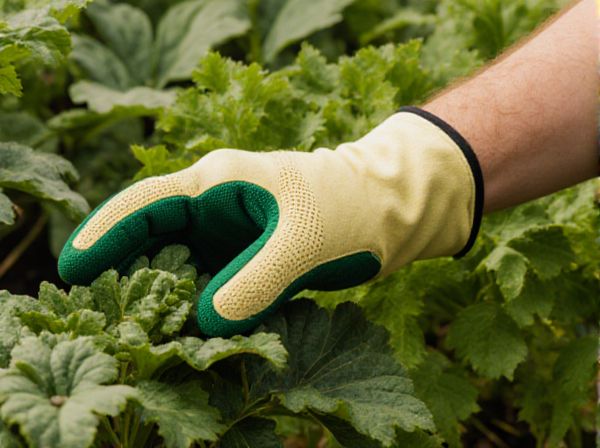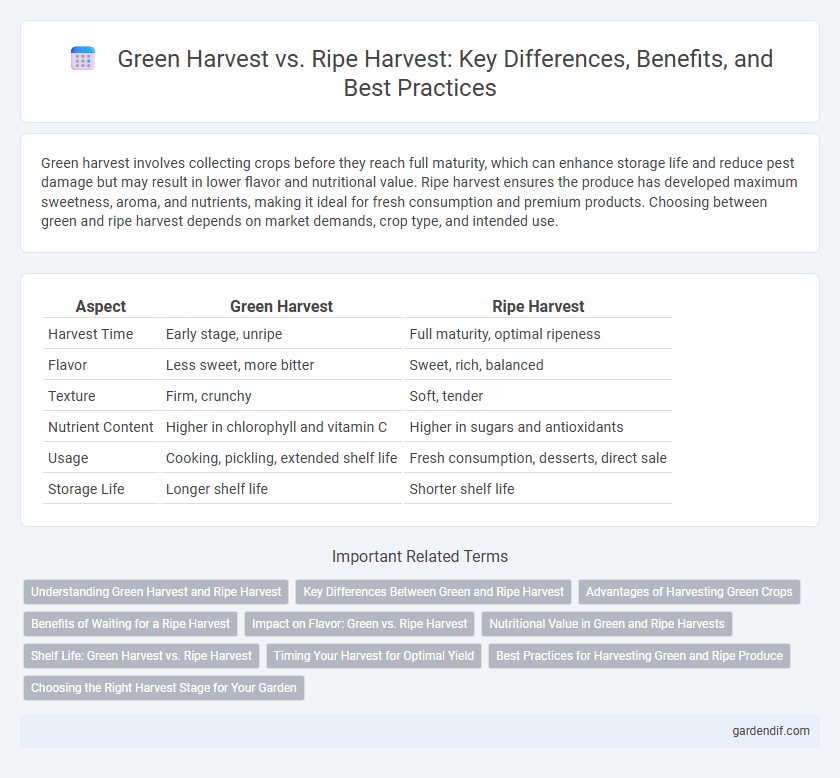
Green Harvest vs Ripe Harvest Illustration
Green harvest involves collecting crops before they reach full maturity, which can enhance storage life and reduce pest damage but may result in lower flavor and nutritional value. Ripe harvest ensures the produce has developed maximum sweetness, aroma, and nutrients, making it ideal for fresh consumption and premium products. Choosing between green and ripe harvest depends on market demands, crop type, and intended use.
Table of Comparison
| Aspect | Green Harvest | Ripe Harvest |
|---|---|---|
| Harvest Time | Early stage, unripe | Full maturity, optimal ripeness |
| Flavor | Less sweet, more bitter | Sweet, rich, balanced |
| Texture | Firm, crunchy | Soft, tender |
| Nutrient Content | Higher in chlorophyll and vitamin C | Higher in sugars and antioxidants |
| Usage | Cooking, pickling, extended shelf life | Fresh consumption, desserts, direct sale |
| Storage Life | Longer shelf life | Shorter shelf life |
Understanding Green Harvest and Ripe Harvest
Green harvest refers to picking crops before they reach full maturity, often to prevent damage from pests or weather, ensuring extended shelf life but potentially sacrificing optimal flavor and nutrient content. Ripe harvest occurs when crops are fully developed, maximizing taste, sweetness, and nutritional value, ideal for fresh consumption and premium produce markets. Understanding the balance between green and ripe harvest times is crucial for farmers to meet specific market demands and maintain crop quality.
Key Differences Between Green and Ripe Harvest
Green harvest occurs when crops are collected before full maturity, preserving firmness and reducing sugar content, which is ideal for certain processing methods. Ripe harvest involves gathering produce at peak maturity, maximizing flavor, sweetness, and nutritional value, suitable for fresh consumption. Key differences include texture, taste intensity, and storage potential, with green harvest favoring longer shelf life and ripe harvest providing optimal taste and nutrient profiles.
Advantages of Harvesting Green Crops
Harvesting green crops offers the advantage of extended shelf life due to lower sugar levels and reduced respiration rates, preserving freshness during transport and storage. Green harvest enables earlier market access, providing farmers with faster cash flow and reducing exposure to adverse weather conditions. Nutrient retention is higher in green-harvested crops, maintaining optimal levels of vitamins and antioxidants compared to fully ripe counterparts.
Benefits of Waiting for a Ripe Harvest
Waiting for a ripe harvest ensures maximum nutrient density, enhanced flavor profiles, and improved shelf life, increasing the overall market value of crops. The biochemical processes during full ripeness boost sugar content and antioxidant levels, essential for consumer health and satisfaction. Moreover, ripe crops exhibit better texture and color, attracting premium buyers and reducing post-harvest losses.
Impact on Flavor: Green vs. Ripe Harvest
Green harvest grapes contain higher levels of acidity and unripe tannins, resulting in wines with a sharper, more astringent flavor profile. Ripe harvest grapes offer balanced sugars and developed phenolics that contribute to richer, sweeter, and more complex taste notes. The timing of the harvest significantly influences the wine's body, sweetness, and overall flavor intensity.
Nutritional Value in Green and Ripe Harvests
Green harvest fruits contain higher levels of vitamin C, antioxidants, and fiber compared to ripe harvest fruits, which tend to have increased sugar content and enhanced flavor profiles. Chlorophyll and certain polyphenols present in green harvest crops contribute to their superior antioxidant capacity, promoting better health benefits. However, ripe harvest produces greater availability of carotenoids and natural sugars, affecting energy levels and taste preferences.
Shelf Life: Green Harvest vs. Ripe Harvest
Green harvest produce typically has a longer shelf life due to lower sugar content and firmer texture, which slows down spoilage and microbial growth. Ripe harvest fruits and vegetables have higher sugar levels and softer tissues, making them more perishable and reducing their storage duration. Proper handling and storage conditions can further extend the shelf life difference between green and ripe harvest products.
Timing Your Harvest for Optimal Yield
Timing your harvest plays a crucial role in maximizing crop yield, with green harvest focused on gathering fruits or vegetables before full ripeness to extend shelf life and reduce spoilage. Ripe harvest ensures the product has reached peak flavor, nutrient density, and market value, though it may have a shorter storage period. Selecting the appropriate harvest time depends on crop type, intended use, and climate conditions to balance yield quantity and quality effectively.
Best Practices for Harvesting Green and Ripe Produce
Harvesting green produce requires precise timing to ensure optimal firmness and extended shelf life, while ripe produce demands careful handling to preserve flavor and reduce bruising. Employing sharp tools and gentle picking techniques minimizes damage, and immediate post-harvest cooling is essential for both types to maintain quality and freshness. Implementing proper storage conditions, such as controlled temperature and humidity, maximizes the longevity and market value of green and ripe fruits and vegetables.
Choosing the Right Harvest Stage for Your Garden
Selecting the optimal harvest stage is crucial for maximizing yield and flavor in your garden. Green harvest crops, like immature peas or unripe tomatoes, offer crunchiness and higher nutrient density, ideal for fresh consumption or specific recipes. Ripe harvest produces fully matured fruits and vegetables with richer sugars and developed flavors, perfect for storage, preserves, or immediate eating.
Green Harvest vs Ripe Harvest Infographic

 gardendif.com
gardendif.com